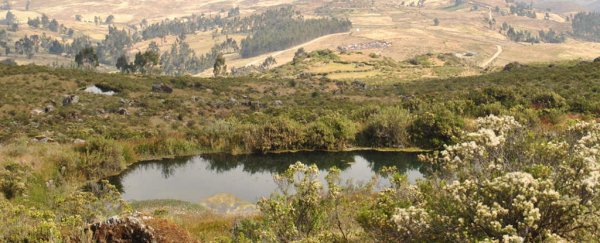An ancient water conservation technique once used in Peru could be making a comeback in the modern era, as the country struggles with extreme dry seasons amidst a population rise.
Researchers estimate the technique - used by indigenous peoples of the region - is at least 1,400 years old. It involves diverting water from streams to mountain slopes when the rain is plentiful, resulting in natural springs that keep water stored over a longer period of time after the rainy season has stopped.
In the pre-Inca age, this was done through the construction of canals and ponds to divert some water away from its natural flow. It would then take months to resurface downstream, right when it was needed.
 Ancient canals in the Andean mountains. (Sam Grainger, Imperial College London)
Ancient canals in the Andean mountains. (Sam Grainger, Imperial College London)
"The people of Lima live with one of the world's least stable water situations," says environmental engineer Wouter Buytaert, from Imperial College London in the UK. "There's too much water in the wet seasons, and too little in the dry ones."
"The indigenous peoples of Peru knew how to get around this, so we're looking to them for answers."
The researchers visited Huamantanga in western Peru, to study one of the few remaining examples of this ancient water system. Here the canals, or "amunas" in the Quechua language, have been recently restored.
Over the course of two years, in consultation with local people, the team found that the rerouted water takes between two weeks and eight months to work its way downstream – an average of 45 days.
Adapting this diversion process for the capital city Lima, the researchers estimate, could mean around 35 percent of wet season water (roughy 99 million cubic metres or around 3.5 billion cubic feet) gets saved up for later months. Scaling up the system is going to be difficult, but it could work.
During the dry season, which lasts from May to October, Peru struggles to keep water available for all 12 million residents of Lima. The seasonal variation between water levels hasn't been helped by climate change and melting glaciers, or by farming methods that have left mountain slopes devoid of water-trapping soil.
By bringing back this ancient technique, the researchers think the amount of water available during the dry season could be boosted by as much as 33 percent in the early months, and by around 7.5 percent during later months.
However, the traditional methods would be used in tandem with more modern approaches, the researchers suggest, to maximise how much water could be saved during times of plenty – and to act as insurance in an ever-changing climate.
In the face of a changing climate, providing enough water for human needs is becoming a growing challenge in some parts of the world, with scientists turning to a variety of different solutions to try and guarantee reliable water supplies in the future.
As it turns out, we might be able to learn something from the techniques practised many centuries ago.
"With the advent of modern science, you'd be forgiven for wondering how ancient methods could apply to modern day problems," says hydrologist Boris Ochoa-Tocachi. "However, it turns out that we have lots to learn from our ancestors' creative problem-solving skills."
The research has been published in Nature Sustainability.
